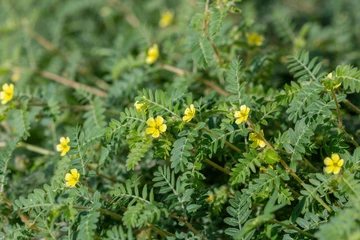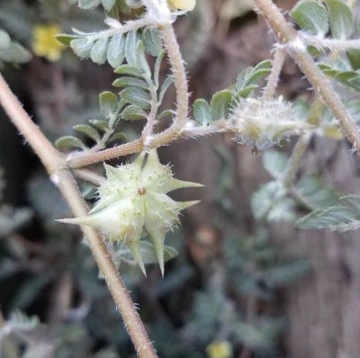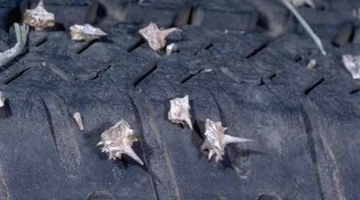Toxic plant puncturevine (also known as caltrop, goathead, cat's-head, devil's thorn, tackweed) is a low growing annual that grows mainly in disturbed areas and sandy soils. It also occurs heavily in overgrazed pastures. Leaves grow opposite of each other and are pinnately compound. Flowers are very small, yellow and have five petals. The seed has two very sharp spikes that resembles a goat head.
Jump To:
Affected livestock
All classes of livestock including are negatively impacted. The plant contains toxic saponins which may contribute to animal bloat. The wilted plant is the most toxic. Additionally, the plant can carry fungal toxins which cause photosensitivity skin damage and in the case of sheep, swelling of the head. Lameness and/or infection can also occur in the feet or mouth from seeds that become embedded in the skin of the animal. May cause liver damage in sheep and goats.
Symptoms
Blindness, peeling skin, swelling of the head area (sheep), loss of lips and ears, nitrate poisoning symptoms, mortality of young animals, jaundice, limping, and inability to eat or graze (from seeds lodged in the animals mouth or throat).
Treatment
Remove animals from problem areas with puncturevine. Provide shade, fresh water and quality hay that is weed free and easily digestible. See veterinarian immediately if poisoning or liver damage is suspected. Anti-inflammatory and anti-histamines may help with photosensitivity burns. Adapt new grazing strategies for more palatable plants. Puncturevine is best controlled by hand removal or hoeing through the taproot. Monitoring the area and removing puncturevine in spring and summer will reduce the impact of the weed the next year. Younger plants are more susceptible to postemergent broadleaf herbicides with the exception of 2,4 -D can control this plant.




